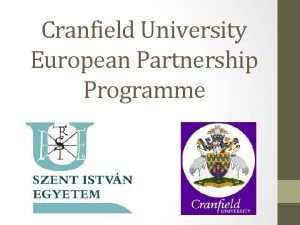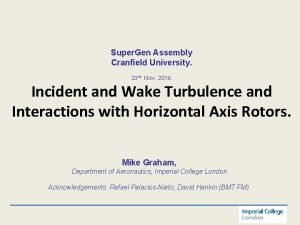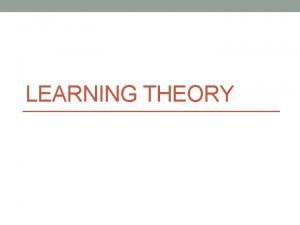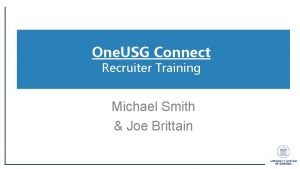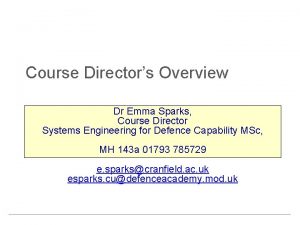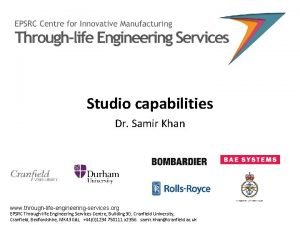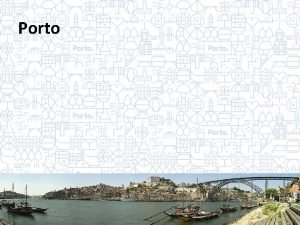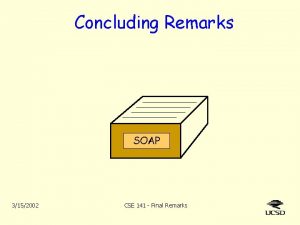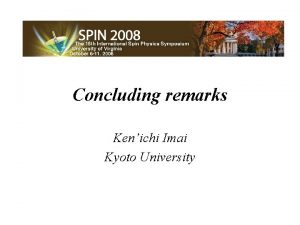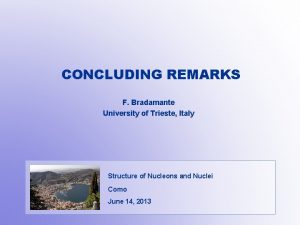Concluding Remarks Nigel Knowles Visiting Professor Cranfield University














- Slides: 14

Concluding Remarks Nigel Knowles Visiting Professor Cranfield University, UK ( Formerly Director of Technology WS Atkins Consultants, UK ) presented at ASRANET / FENET / IStruct. E joint meeting on Computational Mechanics in Structural Safety Risk and Reliability June 2003 6

where are we going…. . . ? 6 l Industry drivers and related issues l technical challenges l how should we respond? With acknowledgements to ASRANET and FENET colleagues!

Evolution of Analysis methods in industry pre 1880 - 'rules of thumb' 1880 - energy methods 1960's - special purpose programs – hardware limited 1970's codes - large scale general purpose analysis 1980's - non-linear optimisation computer graphics error measures probabilistic methods - incorporation into CAE, adaptivity, 'meshless’ f. e. a. 1990's

Typical 70’s issues l l l Solvers Element technology (shell elements!) Post processing Software verification Computer resources – (Can we fit it on the computer and if so will it solve in a sensible time)?

Progress Moores Law Numerical analysis capability now exceeds our ability to make effective use of it? CBIC

Market pressures l Time to market l Operational efficiency l Globalisation l Environmental concerns l Sustainability l Safety culture l PFI/PPI Longer time frames More holistic approaches 6

Ensuing business/technical issues Whole life management and costing l Life extension c. f. new build l • Assessment of existing structures • Ultimate strength analyses • Optimisation l Commercial risk assessment • Treatment of uncertainty • Decision making

Principal Current Issues l Integration of analysis into business processes • Optimisation and decision making l Safety qualification • Extreme events l Confidence • Validation and Q A l Technology transfer • Knowledge dissemination and retention 6

Integration of analysis into business processes l Not just a CAD-FE issue! – – Optimisation wrt to social, commercial and economic issues decision making (under uncertainty) standard procedures data • provenance • curacy • legacy – cultural, human and organisational issues 6

Safety qualification – extreme events (fire, crash, hurricane, earthquake etc) – uncertainty handling • poorly defined phenomena • infrequent occurrences • data provenance Stats/probability is not the complete answer – life extension geriatric structures • Code applicability? • Data • Safety margins? 6

Confidence – – 6 Validation (“fitness for purpose”) Error minimisation Controlling human error Standards and Q A

Technology transfer – Dissemination – Education and training – Don’t forget managers needs! – Legacy knowledge and experience 6

Key messages Integration - Broaden horizons! Safety Qualification - Recognise uncertainty Watch for CBIC! Confidence - still immature Technology transfer - more attention to “managers” needs

 Cranfield’s european partnership programme
Cranfield’s european partnership programme Cranfield university blackboard
Cranfield university blackboard Fordham university rose hill campus map
Fordham university rose hill campus map Lewinda knowles
Lewinda knowles Malcolm knowles theory
Malcolm knowles theory Malcolm knowles
Malcolm knowles Geoff knowles
Geoff knowles Louise knowles dhsc
Louise knowles dhsc Malcolm knowles
Malcolm knowles Bringing in the sheep or sheaves
Bringing in the sheep or sheaves Usgconnect
Usgconnect Promotion from assistant to associate professor
Promotion from assistant to associate professor Emma sparks cranfield
Emma sparks cranfield Dr samir khan
Dr samir khan Bbc bitesize visiting hour
Bbc bitesize visiting hour
